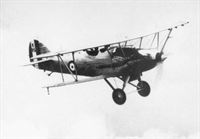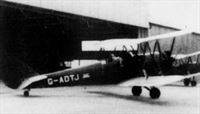Фотографии
-
My dual instruction began in the Hawker Hart, powered by a Rolls-Royce Kestrel X of 510 h.p. The first part of the course repeated the exercises in basic flying training learned at Ansty, but in the heavier service aircraft. The Hart was a pleasure to fly, especially in aerobatics, and it had no vices. I went solo in seven hours and completed 46hr in the aircraft. I was awarded my wings before going on to the advanced part of the course on the Hawker Audax.
Самолёты на фотографии: Hawker Hart - Великобритания - 1928
-
While practising solo forced landings at the adjacent “forced landing" field at Collyweston (now part of RAF Wittering) I experienced my first prang, shown here. After making two successful approaches, on the third I lost flying speed in a sideslip over trees on the boundary, and stalled onto the aerodrome. I had to make out a formal report but was not reprimanded. Nevertheless I felt disconsolate but learnt a lesson from my expensive mistake. In fact, flying accidents during training were common.
Самолёты на фотографии: Hawker Hart - Великобритания - 1928
-
Регистрационный номер: K5679 [2] Some of my course, destined for fighters, received their advanced training on the Hawker Fury instead of the Audax. Here, the trainee pilot had to hit the ground on an air-to-ground firing practice. The pilot flew the aircraft back to the aerodrome with the damaged undercarriage dangling.
Самолёты на фотографии: Hawker Fury - Великобритания - 1931
-
Регистрационный номер: K5679 [2] The aircraft somersaulted onto its back upon hitting the ground, leaving the pilot hanging in his safety harness, uninjured but embarrassed.
Самолёты на фотографии: Hawker Fury - Великобритания - 1931
-
Регистрационный номер: K4982 A heavy ground mist formed at Wittering during the night flying practice. The instructor and trainee pilot overshot the flare path and turned the Hart over onto its back over the boundary hedge.
Самолёты на фотографии: Hawker Fury - Великобритания - 1931
-
Регистрационный номер: K5132 The Hawker Audax differed from the Hart mainly by way of the rear cockpit, which was fitted out for an observer/gunner. Each exercise on the advanced course was carried out by a pair of pilots acting alternately as pilot and observer.
Самолёты на фотографии: Hawker Audax - Великобритания - 1931
-
In practising wind finding and bomb aiming exercises with the course-setting bomb sight, the observer lay prone in the rear cockpit beneath the pilot’s feet, peering through the opening in the floor, frozen and nauseated by fumes from the engine.
Самолёты на фотографии: Hawker Audax - Великобритания - 1931
-
Самолёты на фотографии: Hawker Audax - Великобритания - 1931
-
A formation of 22 Squadron Vildebeest is seen setting course over Chichester Harbour to attack the Navy in combined services exercises in the Channel.
Самолёты на фотографии: Vickers Vildebeest / Type 132 - Великобритания - 1928
-
Регистрационный номер: K4589 At Thorney Island we flew Vildebeests. Here is the Vildebeest Mk III, with the 660 h.p. Pegasus IIM3 engine.
Самолёты на фотографии: Vickers Vildebeest / Type 132 - Великобритания - 1928
-
Here we see a Vildebeest dropping a practice torpedo in Stokes Bay.
Самолёты на фотографии: Vickers Vildebeest / Type 132 - Великобритания - 1928
-
The Vildebeest had the unusual, rather vicious Vickers air brakes. Air pressure in the brake system was pumped up to 400lb/in2 in the air or before taxying. Attempts to pump up any more pressure whilst moving could result in something like this.
Самолёты на фотографии: Vickers Vildebeest / Type 132 - Великобритания - 1928
-
Регистрационный номер: G-ADTJ My first introduction to flying was in an Avro 643 Cadet with a Genet Major 1A engine of 140 h.p. I had no difficulty in flying the aircraft, but I found it hard to sort out my approaches under different wind conditions. My second instructor soon rectified this, but even so I took a worrying long time to go solo - 17hr!
Самолёты на фотографии: Avro Cadet / Type 631/643 - Великобритания - 1932
Статьи
- -
- Personal album
- Skywriters
- Supermarine Spitfire LF.Mk VIII MT719
- ??? - Lizzie bites the dust
- C.Pocock - Dragon Lady. The accident file (1)
- J.Allan - Down in the Glen
- J.King - Foxes in the Roaring Forties (1)
- J.Pelly-Fry - Wellesleys over the Sudan (3)
- J.Stroud - Wings of Peace
- N.Hearn-Phillips - Pilot's progress
- P.Jarrett - A Walrus to catch a whale
- P.Jarrett - Grapevine
- R.Riding - Unscheduled arrival












